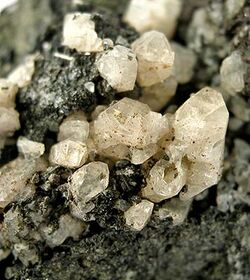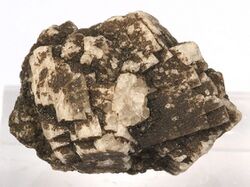Chemistry:Anorthite
| Anorthite | |
|---|---|
 | |
| General | |
| Category | Feldspar |
| Formula (repeating unit) | CaAl2Si2O8 |
| Strunz classification | 9.FA.35 |
| Crystal system | Triclinic |
| Crystal class | Pinacoidal (1) (same H-M symbol) |
| Space group | P1 |
| Unit cell | a = 8.1768, b = 12.8768 c = 14.169 [Å]; α = 93.17° β = 115.85°, γ = 92.22°; Z = 8 |
| Identification | |
| Formula mass | 278.203 g·mol−1 |
| Color | White, grayish, reddish |
| Crystal habit | Anhedral to subhedral granular |
| Twinning | Common |
| Cleavage | Perfect [001] good [010] poor [110] |
| Fracture | Uneven to conchoidal |
| Tenacity | Brittle |
| Mohs scale hardness | 6 |
| |re|er}} | Vitreous |
| Streak | White |
| Diaphaneity | Transparent to translucent |
| Specific gravity | 2.72–2.75 |
| Optical properties | Biaxial (−) |
| Refractive index | nα = 1.573–1.577 nβ = 1.580–1.585 nγ = 1.585–1.590 |
| Birefringence | δ = 0.012–0.013 |
| 2V angle | 78° to 83° |
| Melting point | 1553 °C[1] |
| References | [2][3][4] |
Anorthite (an = not, ortho = straight) is the calcium endmember of the plagioclase feldspar mineral series. The chemical formula of pure anorthite is CaAl2Si2O8. Anorthite is found in mafic igneous rocks. Anorthite is rare on the Earth[6] but abundant on the Moon.[7]
Mineralogy
Anorthite is the calcium-rich endmember of the plagioclase solid solution series, the other endmember being albite (NaAlSi3O8). Anorthite also refers to plagioclase compositions with more than 90 molecular percent of the anorthite endmember. The composition of plagioclases is often expressed as a molar percentage of An%, or (for a specific quantity) Ann, where n = Ca/(Ca + Na) × 100.[8] This equation predominantly works in a terrestrial context; exotic locales and in particular Lunar rocks may need to account for other cations, such as Fe2+, to explain differences between optically and structurally derived An% data observed in Lunar anorthites.[9]
At standard pressure, pure (An100) anorthite melts at 1,553 °C (2,827 °F).[1]
Occurrence
Anorthite is a rare compositional variety of plagioclase. It occurs in mafic igneous rock. It also occurs in metamorphic rocks of granulite facies, in metamorphosed carbonate rocks, and corundum deposits.[2] Its type localities are Monte Somma and Valle di Fassa, Italy. It was first described in 1823.[4] It is more rare in surficial rocks than it normally would be due to its high weathering potential in the Goldich dissolution series.
It also makes up much of the lunar highlands; the Genesis Rock, collected during the 1971 Apollo 15 mission, is made of anorthosite, a rock composed largely of anorthite. Anorthite was discovered in samples from comet Wild 2, and the mineral is an important constituent of Ca-Al-rich inclusions in rare varieties of chondritic meteorites.
See also
- List of minerals
- Lunar highlands
- Lunar regolith
References
- ↑ 1.0 1.1 J.R. Goldsmith (1980): The melting and breakdown reactions of anorthite at high pressures and temperatures. Am. Mineralogist. 65, 272-284, http://www.minsocam.org/ammin/AM65/AM65_272.pdf
- ↑ 2.0 2.1 Handbook of Mineralogy
- ↑ Mindat
- ↑ 4.0 4.1 Webmineral
- ↑ Warr, L.N. (2021). "IMA–CNMNC approved mineral symbols". Mineralogical Magazine 85 (3): 291–320. doi:10.1180/mgm.2021.43. Bibcode: 2021MinM...85..291W.
- ↑ Deer, W.A., Howie, R.A. and Zussman, J. (1966). An Introduction to the Rock Forming Minerals. London: Longman. pp. 336. ISBN 0-582-44210-9.
- ↑ "Significant Lunar Minerals". In Situ Resource Utilization (ISRU). NASA. https://isru.msfc.nasa.gov/lib/Documents/PDF%20Files/Significant_Lunar_Minerals.pdf.
- ↑ Bennett, Emma N.; Lissenberg, C. Johan; Cashman, Katharine V. (21 May 2019). "The significance of plagioclase textures in mid-ocean ridge basalt (Gakkel Ridge, Arctic Ocean)". Contributions to Mineralogy and Petrology 174 (6). doi:10.1007/s00410-019-1587-1.
- ↑ Wenk, H. -R.; Wilde, W. R. (1 August 1973). "Chemical anomalies of Lunar plagioclase, described by substitution vectors and their relation to optical and structural properties". Contributions to Mineralogy and Petrology 41 (2): 89–104. doi:10.1007/BF00375035.
 |


